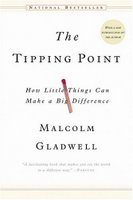This is the second book I've read by Gladwell, and thoroughly enjoyed both. His writing is clear, making subjects that could be very confusing understandable to the common human. This particular book is about epidemics of any variety -- diseases, trends, success stories. Gladwell describes three main factors -- the law of the few, the stickiness factor, and the power of context. Some ideas are intuitive and others don't make any sense on their own. In the afterword (which was added in the second edition), Gladwell shares some of the stories he's heard as a result of this book. It is exciting to see that by being wise and careful in how we go about things, the effects can be greater.
The first factor is called the law of the few, which is the idea that some people have power in the specific senses that allow them to influence the masses. These three types of people are connectors, who know people from all walks of life and maintain these relationships well; mavens, who gather information and want to share it, such as knowing what car is the best deal and why; and salesmen, who can convince anyone their message is useful and helpful. These sorts of people all have power in different senses which can help social epidemics to 'tip.'
The second factor is called the stickiness factor, which means that for something to 'tip' it must be memorable. Sometimes this can just be a certain image, or directions to a location. It doesn't make intuitive sense that adding or taking away one detail could affect how well the message is remembered. The third factor is the power of context, which means that our environments do have a greater amount of control than we expect. For instance, they decided to deal with the graffiti on the subway cars and the farebeaters who jumped over the turnstiles, and greatly decreased the crime because the environment made people feel safer and less likely to act criminally because they didn't have examples in front of their faces.
Gladwell is definitely a translator. By this I mean that he is able to take research from specialized fields and combine them to prove his thesis. Not only that, but he does so in a manner that makes sense in daily life by taking examples from things most Americans know like Sesame Street and smoking. His books read fairly quickly and some important ideas stick with you (stickiness factor!), as well as a new way of understanding this world we get to live in.
| Title: | The Tipping Point: How Little things Can Make a Big Difference |
|---|---|
| Author: | Malcolm Gladwell |
| Date published: | 2000 |
| Genre: | Popular Science |
| Number of pages: | 280 |



0 comments:
Post a Comment